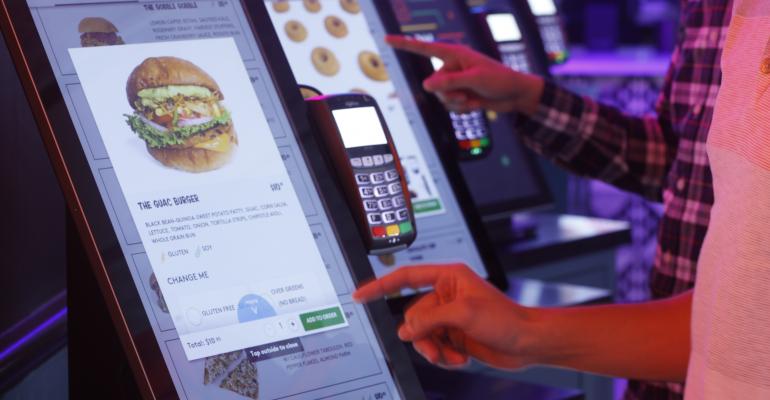Sponsored by Bite
Before COVID-19 altered the foodservice industry, restaurant technology seemed like a luxury investment to some operators. But a year-and-a-half after the disease arrived in the U.S., online, mobile and customer-facing kiosk ordering options now seem to be mandatory for quick-service and fast-casual operators.
As restaurant dine-in options ceased in March of 2020, operators scrambled to serve customers through takeout and delivery channels only. But to continue serving food and drink, direct contact between employees and customers had to stop. That led to the evolution of new tools designed to keep both parties safely distanced at the point of pickup. The pivot required to adapt to those new technologies was disruptive but necessary, says Liam Farrow, vice president of digital at 50-unit Bluestone Cafés and Coffee Shops.
“The pandemic is what led to our digital revolution, especially in our larger markets like New York, Los Angeles, San Francisco and Washington, D.C.,” Farrow says. “On March 14, we went mobile only. It was the only way we could remain part of our communities while keeping our employees safe.”
Bluestone’s earlier investments in order-ahead technology gave the chain a platform with which to refine its mobile-dining options. And, updated for increased use, mobile pickup and delivery orders surged from 5% of all transactions to more than 90%.
But when relaxed COVID restrictions allowed customers to enter restaurants again, the company turned to self-order kiosks as a way to keep guests and employees comfortably distanced while providing a pleasant ordering experience.
“Sometimes we were running such lean operations that only one person would be there to assist customers,” Farrow says. “But having a kiosk meant we could do that successfully with such a small staff.”
Once restrictions relaxed and more customers came inside, he says, “kiosks allowed us to manage the increased order traffic really well.”
Bluestone worked with Bite, a New York City-based omnichannel order-platform provider for restaurants, to configure its stores with digital-order kiosks. Bite’s kiosks facilitate contactless ordering and payment seamlessly and graphically. Farrow says he was surprised when orders made through kiosks at its coffee shops pushed average transactions 50% higher.
“That’s a dramatic lift in average check at a coffee shop,” says Farrow, adding that the increase was from $8 to $12. He credits the sales increases to menu suggestions displayed vividly on the kiosks’ screens. “Since people eat with their eyes first, they’ll get the coffee that they wanted, but then they say, ‘I’ll get some avocado toast, too.’”
Hospitality first
Farrow says that Bluestone’s service model centers on “Australian hospitality,” meaning fun and friendly customer engagement. So Bluestone’s Aussie owners were initially concerned that digital-ordering options could reduce the warm human interaction for which Bluestone is known. As it turns out, Farrow says, the digital kiosks did just the opposite.
“We train our teams on the belief that any technology added is meant to augment service, not to remove hospitality,” Farrow says. “What we saw was service changed from an exchange that was less about the transaction to a conversation with the barista. It actually made visiting our coffee shops more of an experience.”
Farrow says the new kiosks also increased order-fulfillment speed “drastically” and boosted order accuracy. Relieved of order taking at POS terminals, counter workers now were freed to perform other tasks that improved the whole order process. And with delivery making up about 25% of all transactions post-pandemic, Farrow says all its kitchens will eventually be outfitted with KDS’s to further improve order accuracy and speed in that channel.
Farrow says the shift to mobile and digital kiosks wasn’t without its challenges. Not every customer liked the shift to cashless transactions. But the majority of its core customers—“digital natives” between the ages of 24 and 35—welcomed it, he adds. Figuring out where to place the kiosks in stores also took some adjusting. As in-store orders increased, the inevitable queue formed and sometimes complicated customer movement through the space. However, Farrow says, Bite’s kiosks are lightweight and easily maneuvered.
“We were constantly moving them around to see what worked best,” he says. “But what’s good is they can be installed on a counter or on a wall.”
Despite those early hurdles, all proved minor compared to the gains afforded Bluestone when using Bite’s technology.
“We’ve made a strategic decision to be tech-enabled,” Farrow says. “We want the right balance between human touch and technology that removes any friction from the experience for our customers, and makes it as easy as possible for our team to serve them.”



